Year 3
The English curriculum is built around the three interrelated strands of language, literature and literacy. Teaching and learning programs should balance and integrate all three strands. Together, the strands focus on developing students' knowledge, understanding and skills in listening, reading, viewing, speaking, writing and creating. Learning in English builds on concepts, skills and processes developed in earlier years, and teachers will revisit and strengthen these as needed.
In Years 3 and 4, students experience learning in familiar contexts and a range of contexts that relate to study in other areas of the curriculum. They interact with peers and teachers from other classes and schools in a range of face-to-face and online/virtual environments.
Students engage with a variety of texts for enjoyment. They listen to, read, view and interpret spoken, written and multimodal texts in which the primary purpose is aesthetic, as well as texts designed to inform and persuade. These encompass traditional oral texts including Aboriginal stories, picture books, various types of print and digital texts, simple chapter books, rhyming verse, poetry, non-fiction, film, multimodal texts, dramatic performances and texts used by students as models for constructing their own work.
The range of literary texts for Foundation to Year 10 comprises Australian literature, including the oral narrative traditions of Aboriginal and Torres Strait Islander Peoples, as well as the contemporary literature of these two cultural groups, and classic and contemporary world literature, including texts from and about Asia.
Literary texts that support and extend students in Years 3 and 4 as independent readers describe complex sequences of events that extend over several pages and involve unusual happenings within a framework of familiar experiences. Informative texts include content of increasing complexity and technicality about topics of interest and topics being studied in other areas of the curriculum. These texts use complex language features, including varied sentence structures, some unfamiliar vocabulary, a significant number of high-frequency sight words and words that need to be decoded phonically, and a variety of punctuation conventions, as well as illustrations and diagrams that support and extend the printed text.
Students create a range of imaginative, informative and persuasive types of texts including narratives, procedures, performances, reports, reviews, poetry and expositions.
(source: www.australiancurriculum.edu.au)
Achievement Standard
Receptive modes (listening, reading and viewing)
By the end of Year 3, students understand how content can be organised using different text structures depending on the purpose of the text. They understand how language features, images and vocabulary choices are used for different effects.
They read texts that contain varied sentence structures, a range of punctuation conventions, and images that provide extra information. They use phonics and word knowledge to fluently read more complex words. They identify literal and implied meaning connecting ideas in different parts of a text. They select information, ideas and events in texts that relate to their own lives and to other texts. They listen to others' views and respond appropriately using interaction skills.
Productive modes (speaking, writing and creating)
Students understand how language features are used to link and sequence ideas. They understand how language can be used to express feelings and opinions on topics. Their texts include writing and images to express and develop, in some detail, experiences, events, information, ideas and characters.
Students create a range of texts for familiar and unfamiliar audiences. They contribute actively to class and group discussions, asking questions, providing useful feedback and making presentations. They demonstrate understanding of grammar and choose vocabulary and punctuation appropriate to the purpose and context of their writing. They use knowledge of letter-sound relationships including consonant and vowel clusters and high-frequency words to spell words accurately. They re-read and edit their writing, checking their work for appropriate vocabulary, structure and meaning. They write using joined letters that are accurately formed and consistent in size.
(source: www.australiancurriculum.edu.au)
- Plus Plan
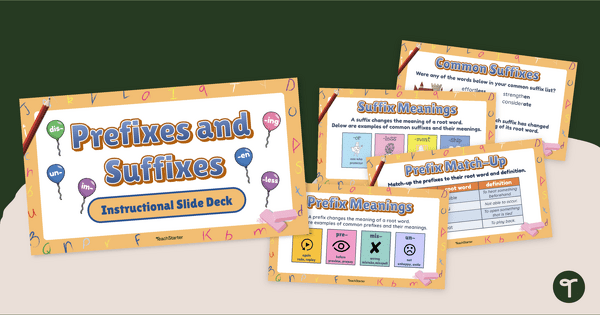
Prefixes and Suffixes PowerPoint
Learn prefix and suffix concepts with an interactive teaching presentation.
- Plus Plan
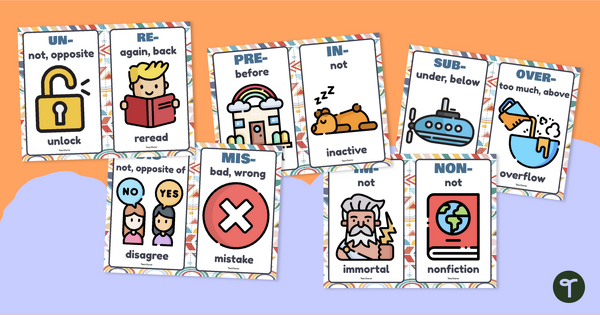
Mini Anchor Charts - Prefixes
Give your students a visual reminder of the meanings of 36 different prefixes with a printable set of miniature prefix anchor charts.
- Plus Plan

Instructional PowerPoint - Prefixes
Teach your students to correctly identify, define, and spell words with common prefixes with an interactive teaching presentation.
- Plus Plan

Level 7 Decodable Readers - Worksheet Pack
A set of one-pager worksheet versions of the texts from our Level 7 decodable readers.
- Plus Plan

Boring Chores - Decodable Reader (Level 7)
Develop confident, successful readers with this phonics-based, printable decodable book.
- Plus Plan

The Storm - Decodable Reader (Level 7)
Develop confident, successful readers with this phonics-based, printable decodable book.
- Plus Plan

The Mystery Door - Decodable Reader (Level 7)
Develop confident, successful readers with this phonics-based, printable decodable book.
- Plus Plan

What to Be? - Decodable Reader (Level 7)
Develop confident, successful readers with this phonics-based, printable decodable book.
- Plus Plan

The Spoilt Royal - Decodable Reader (Level 6)
Develop confident, successful readers with this phonics-based, printable decodable book.
- Plus Plan

The Birthday Surprise - Decodable Reader (Level 6)
Develop confident, successful readers with this phonics-based, printable decodable book.
- Plus Plan

Avoid the Germs! - Decodable Reader (Level 6)
Develop confident, successful readers with this phonics-based, printable decodable book.
- Plus Plan

Scarlett the Spider - Decodable Reader (Level 6)
Develop confident, successful readers with this phonics-based, printable decodable book.
- Plus Plan

Level 6 Decodable Readers - Worksheet Pack
A set of one-pager worksheet versions of the texts from our Level 6 decodable readers.
- Plus Plan

Elements of a Story Activity Workbook
Explore the different elements of a narrative story with this student mini workbook.
- Plus Plan

Exploring Verb Tenses - Interactive Activity
Provide your students with a digital learning activity to practise using past, present, and future tense verbs.
- Plus Plan
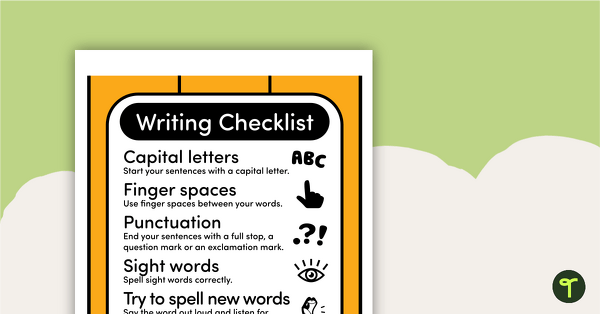
Writing Conventions Poster
Get your students using this writing conventions poster to edit their work across multiple genres.
- Free Plan

Mysterious Story Setting Background Posters
A set of 3 mysterious story setting posters for students to use in a variety of ways.
- Plus Plan

Narrative Writing Bump It Up Wall – Year 3
A visual display for your classroom to help students ‘bump up’ their narrative writing.
- Plus Plan

How to Make a Milkshake – Procedural Writing Worksheet
Explore how to make a milkshake while your students fine-tune their procedural writing skills.
- Plus Plan

Letter Writing - Template
An example and template on how to write a formal letter.
- Plus Plan

Alliteration Poster For Young Students
A poster to use with young students when teaching alliteration.
- Free Plan
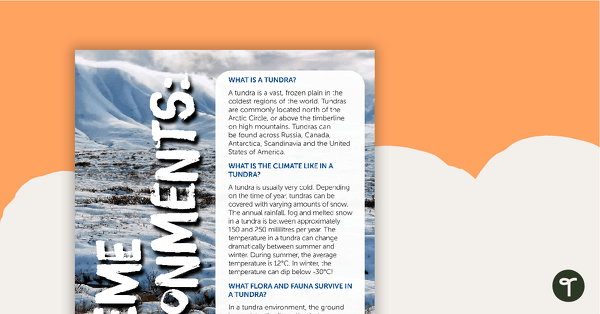
Extreme Environments: Lands of Ice and Sand – Worksheet
A comprehension worksheet for an information report from the Year 4 magazine (Issue 3).
- Plus Plan

Animal Poetry Task Cards
Get your students writing simple animal poetry with this set of 12 poetry prompt task cards.
- Plus Plan
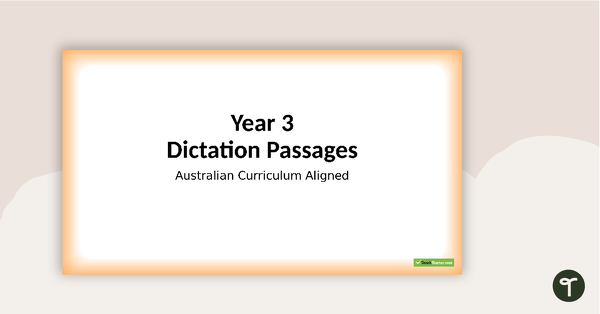
Year 3 Dictation Passages PowerPoint
Use this set of Year 3 dictation passages to promote listening and transcription skills in your students.
- Plus Plan

Sentence Saga Literacy Activity (Silly Sentences)
Words and punctuation marks are jumbled everywhere. It’s your task to combine them into sentences that make sense!
- Free Plan

Personal Recount Planning Template
A template for students to use when planning a personal recount.
- Plus Plan

NAPLAN-Style Assessment Rubric - Procedural Writing
A NAPLAN-style rubric designed to help teachers to assess students' procedural writing.
- Plus Plan

Homophones Crossword Puzzle
Challenge your students to complete this vocabulary crossword puzzle by completing the sentences with the correct homophone.
- Plus Plan

Readers' Theatre Script - Hare and Tortoise
A script which can be used during readers' theatre or Drama sessions, aimed at students 6 years and over.
- Plus Plan

Readers' Theatre Script - Hansel and Gretel
A script which can be used during readers' theatre or Drama sessions, aimed at students 6 years and over.
- Plus Plan

Before, During and After Reading Non-Fiction - Question Prompts
Question prompts and a worksheet to use when asking questions before, during and after reading.
- Plus Plan
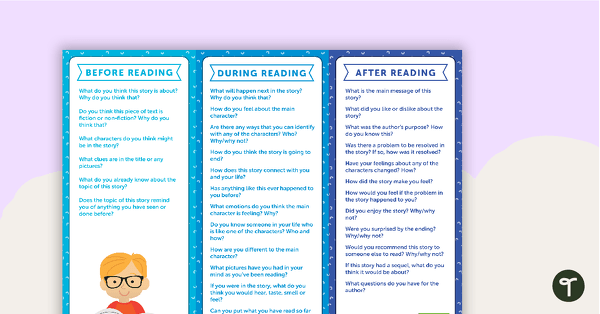
Before, During and After Reading Fiction - Question Prompts
Question prompts and a worksheet to use when asking questions before, during and after reading.